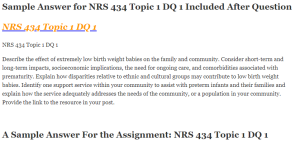NRS 434 Topic 1 DQ 1
Sample Answer for NRS 434 Topic 1 DQ 1 Included After Question
NRS 434 Topic 1 DQ 1
Describe the effect of extremely low birth weight babies on the family and community. Consider short-term and long-term impacts, socioeconomic implications, the need for ongoing care, and comorbidities associated with prematurity. Explain how disparities relative to ethnic and cultural groups may contribute to low birth weight babies. Identify one support service within your community to assist with preterm infants and their families and explain how the service adequately addresses the needs of the community, or a population in your community. Provide the link to the resource in your post.
A Sample Answer For the Assignment: NRS 434 Topic 1 DQ 1
Title: NRS 434 Topic 1 DQ 1
It is essential to note that low birth weight is a significant contributor to infant mortality in the United States (Santos et al., 2021). Low birth weights can occur because of premature birth or socioeconomic factors that may affect the mother’s nutrition during pregnancy. Low birth weight affects family finances and burdens caretakers, negatively impacting families because they will need to spend more time and money to take care of the newborn. It leads to stresses that affect the functioning and socioeconomic status of the family (Drotar et al., 2006). Poor suckling, respiratory problems, and poor muscle tone impact the baby’s health in the short term. A baby born prematurely may be prone to organ dysfunction and metabolic syndromes, such as hypertension and diabetes in the long term (Luu et al., 2016).
Lack of good health care and environmental factors which create stressors for ethnic minorities can affect their ability to access good healthcare during pregnancy and after delivery. Socioeconomic background and poverty affect one’s health leading to premature and low birth weights. Also, poor nutritional habits affect one’s pregnancy, leading to low birth weights (Sims et al., 2008).
The Graham Foundation is a support group for premature babies and their families in Ohio. It provides breastfeeding/pumping support, parents wellness, parent support for lung and breathing issues. In the process of the loss of a baby, they give grieving support to the family to ensure their well-being and adapt to the changes in their family. https://grahamsfoundation.org/#

References
Drotar, D., Hack, M., Taylor, G., Schluchter, M., Andreias, L., & Klein, N. (2006). The impact of extremely low birth weight on the Families of school-aged children. Pediatrics, 117(6), 2006–2013. https://doi.org/10.1542/peds.2005-2118
Luu, T. M., Katz, S. L., Leeson, P., Thébaud, B., &Nuyt, A. M. (2016). Preterm birth: Risk factor for early-onset chronic diseases. Canadian Medical Association Journal, 188(10), 736–746. https://doi.org/10.1503/cmaj.150450
Santos, R. M. D. S., Marcon, S. S., Marquete, V. F., Gavioli, A., Silva, A. M. N. D., Vieira, V. C. D. L., & Marques, A. G. (2021). Prevalence and factors associated with low birth weight in full-term newborns. Rev Rene, 22, e68012. https://doi.org/10.15253/2175-6783.20212268012
Sims, M., Sims, T. L., & Bruce, M. A. (2008). Race, ethnicity, concentrated poverty, and low birth weight disparities. Journal of National Black Nurses’ Association : JNBNA, 19(1), 12–18.
This is an outstanding work and I agree with you. Essentially, extremely low birth weight babies experience many challenges and the condition is associated with various complications. The tiny body of the baby is weak compared to normal birth weight. Therefore, the baby is likely to face challenges in fighting infections, gaining weight, feeding, and staying warm because of lack of sufficient fats on the body (Adams et al., 2018). The lower birth weight makes the babies vulnerable for various complications such as sudden infant death syndrome (SIDA), Retinopathy of prematurity (ROP), infections, infant respiratory distress syndrome, Persistent ductus arteriosus (PDA), jaundice, and Nervous system problems such as necrotizing enterocolitis. Moreover, the long-term disability and complications risks associated with low birth weight include deafness, developmental delay, blindness, and cerebral palsy (Sabbaghchi et al., 2020). The best way for mothers to prevent low birth weight is routine prenatal care. During the prenatal visits, health care professionals assess the health of both the baby and the mother. It is also important to ensure healthy diet and avoid using drugs, smoking, and alcohol during pregnancy (Cunningham et al., 2019). 
References
Adams, M., Bassler, D., Bucher, H. U., Roth-Kleiner, M., Berger, T. M., Braun, J., & Von Wyl, V. (2018). Variability of very low birth weight infant outcome and practice in Swiss and US neonatal units. Pediatrics, 141(5). https://doi.org/10.1542/peds.2017-3436
Cunningham, S. D., Lewis, J. B., Shebl, F. M., Boyd, L. M., Robinson, M. A., Grilo, S. A., … & Ickovics, J. R. (2019). Group prenatal care reduces risk of preterm birth and low birth weight: a matched cohort study. Journal of Women’s Health, 28(1), 17-22. https://doi.org/10.1089/jwh.2017.6817
Sabbaghchi, M., Jalali, R., & Mohammadi, M. (2020). A Systematic Review and Meta-analysis on the Prevalence of Low Birth Weight Infants in Iran. Journal of pregnancy, 2020. https://doi.org/10.1155/2020/3686471
A healthy infant’s weight is between 2,500 g and 4,000 g. The extremely low-birthweight (ELBM) infant, one who is born weighing less than 1,000 g, is a frequent resident of most neonatal intensive care units (NICUs) these days (Kenner & Lott, 2013). ELBM infants can be at risk for many postnatal complications such as respiratory, cardiovascular, and neurological abnormalities. Families with ELBM infants have higher stress compared to those families with healthy babies.
For short-term impacts, when the infant is in NICU, parents or family may be fair because of the unknown and worried about the possibility of illness or even death. Parents may experience powerlessness when they see their baby surrounded by may equipment. For long-term impacts, caring for a child with health challenges may bring a huge burden for a family, especially for those with low socioeconomic status. Taking a child with ELBM may increase caretaking work and increase household spending.
The comorbidities associated with prematurity include respiratory distress syndrome, difficulty regulating body temperature, bronchopulmonary dysplasia, intraventricular hemorrhage, periventricular leukomalacia, necrotizing enterocolitis, sepsis, anemia, and retinopathy of prematurity. ELBM infants are more likely to have health problems later in their lives as well. Only about 20 percent of premature and low birth weight babies go on to have no health problems at all (Kansas City Obgyn, n.d.). Medical care and nutrition needs at critical times are important to assist the baby to have better outcomes and prevent some health problems.
Maternal age, race and ethnicity, education level, smoking status during pregnancy, and parity are significant risk factors for low birth weight. There are large disparities in the prevalence of LBW by race and ethnicity, especially between African American and White women (Ratnasiri et al, 2018). Black women are 2 to 3 times more likely to give birth prematurely and 3 times more likely to have a low-birth-weight baby (Black Women’s Health Imperative, 2017). When assessing an infant, the nurse can keep the goals of Healthy People 2020 in mind. This government campaign seeks to reduce health and health care inequalities, despite a person’s economic, social, educational level, ethnicity, race, age, gender, or location (Green, 2018).
Hailey’s Hope Foundation is a Nonprofit Organization that supports the emotional, financial, and educational needs of NICU families, together we are inspiring hope, helping parents cope, and giving NICU babies a greater fighting chance (Hailey’s Hope Foundation, n.d.). Resources is available to be found at https://www.haileyshopefoundation.org/about-us/our-mission/
References
Black Women’s Health Imperative. (2017). Low Birth Weight Babies And Black Women: What’s The Connection? Retrieved from https://bwhi.org/2017/07/23/low-birth-weight-babies-black-women-connection/
Green, S. Z. (2018). Grand Canyon University (E.D). Foundations for Effective Practice. Retrieved from https://lc.gcumedia.com/nrs434vn/health-assessment-foundations-for-effective-practice/v1.1/#/chapter/1
Hailey’s Hope Foundation. (n.d.). Our mission. Retrieved from https://www.haileyshopefoundation.org/about-us/our-mission/
Kansas City Obgyn. (n.d.). Understanding Low Birth Weight. Retrieved from https://www.kcobgyn.com/blog/low-birth-weight
Kenner, C., & Lott, J. (Eds.). (2013). Comprehensive neonatal nursing care: Fifth edition. ProQuest Ebook Central https://ebookcentral-proquest-com.lopes.idm.oclc.org
Ratnasiri, A.W.G., Parry, S.S., Arief, V.N. et al. (2018). Recent trends, risk factors, and disparities in low birth weight in California, 2005–2014: a retrospective study. matern health, neonatol and perinatol 4, 15 Retrieved from https://doi.org/10.1186/s40748-018-0084-2
Your post on extremely low-birth weight infants is detailed, clear, and well done. Other than the complications on the infants, their mothers and care givers also encounter several challenges. For instance, the mothers of infants experiences considerable discrimination and stigma at the family and community levels. They are often accused of failing to take care of themselves and their infants and also being perceived to have diseases such as HIV/AIDS (Koenraads et al., 2017). The parents of extremely low-birth weight infants also experience feelings of shame and fail to attend vital community support systems such as women groups and clinics due to fear of mockery (Mehta et al., 2019). Moreover, the other challenge is the high burden of care. Extremely low-birth weight infants require more critical care, which is associated with high burden, especially on struggling families. Moreover, extremely low-birth weight infants are perceived to be more challenging to care for since they need extra care, have problems in feeding and are often ill. As such, mothers find it challenging to balance the care for the infants with other duties (Prabhakaran & Arulappan, 2021).
References
Koenraads, M., Phuka, J., Maleta, K., Theobald, S., & Gladstone, M. (2017). Understanding the challenges to caring for low birthweight babies in rural southern Malawi: a qualitative study exploring caregiver and health worker perceptions and experiences. BMJ Global Health, 2(3), e000301. http://dx.doi.org/10.1136/bmjgh-2017-000301
Mehta, T. M., Schmidt, L. A., Poole, K. L., Saigal, S., & Van Lieshout, R. J. (2019). Psychiatric History in the Family Members of Adults Born at Extremely Low Birth Weight. Journal of Child and Family Studies, 28(7), 1948-1954. https://doi.org/10.1007/s10826-019-01420-w
Prabhakaran, H., & Arulappan, J. (2021). Effectiveness of Nurse led structured teaching programme on knowledge and practice of postnatal mothers on low birth weight care. Journal of Neonatal Nursing, 27(3), 200-205. https://doi.org/10.1016/j.jnn.2020.09.004
See Also: NRS 434 Topic 1 DQ 2

